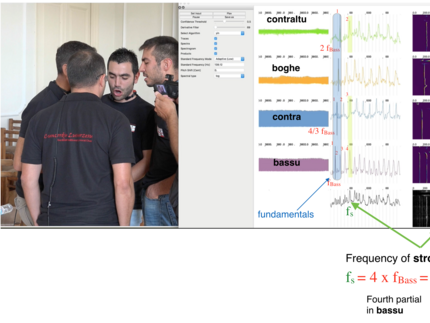The Quintina: Four Singers, Five Voices
Larynx microphones become extremely useful when one wants to study situations where singers perform in close physical contact and exercise very subtle voice interactions in order to achieve a particular acoustic results. This is for example the case with the Sardinian singing style of the Quintina in which four singers manage to fuse the high frequency partials of their voices in such a way that an apparent fifth voice appears (Lortat-Jacob, 1993;1998, Castellengo et al, 2001). During the 8th International Symposium on Traditional Polyphony in Tbilisi in 2018, Frank Scherbaum had the opportunity to witness and record this phenomenon with the Sardinian group Concordu Lussurzesu, who generously accepted to participate in a recording session with larynx microphones.
The following three videos document the religious song Miserere (Lord have mercy on us), usually performed during the week before Easter in the context of the related rituals. The first one was taken from a Sardinian television show and is intended to provide the full version of the song together with an impression of the stage version of this song.
This video was taken from a Sardinian television show and is intended to provide the full version of the song together with an impression of the stage version of this song.
The second video shows the recording made at the Tbilisi State Conservatory in 2016. On the left, one can see the singers while the right part of the movie shows the output of the Pytch program (Kriegerowski and Scherbaum, 2017). This program performs a simultaneous real-time analysis of multi-channel audio recordings and their visualisation in terms of waveform and spectral representations together with identified fundamental frequencies („pitches“) as well as of the intervals between the channels. The analysis and visualisation is performed in Python using pyaudio, aubio and QT5.
Displayed from left to right are the control panel, the waveforms of the individual microphone channels. the spectra (plus the product spectrum of all four channels). the spectrograms (plus the product spectrogram of all four channels) and finally the absolute pitches in cents, relative to a chosen reference frequency. Each voice is color coded differently. The latter display was chosen to accomodate the logarithmic perception of pitch.
Here, the display of Pytch was changed such a way that the display of the absolute pitches was replaced by the display of the relative pitches with respect to the bass voice. This allows to follow the development of the harmonic content of the song. Note at about 30 seconds in the song, a yellow vertical band appears on the spectrogram panels at the frequency which becomes strongly enhanced by the fusion of the overtones of the bass, middle, and top voice. To appreciate this phenomenon audibly, make sure to use loudspeakers or headsets of sufficient quality.
In the present example of Miserere, the fourth partial of the "bassu" voice fuses with the third partial of the "contra" voice and the second partial of the "contraltu" voice. As a consequence, the double octave with respect to the bass voice pitch becomes strongly enhanced towards the end of the video. For a in-depth discussion of the "Quintina" see Lortat-Jacob (1993, 1998), Castellengo et al. (2001), and Castellengo (2015).
References
- Castellengo, M., Lortat-Jacob, B., & Léothaud, G. (2001). PITCH PERCEPTION : FIVE VOICES WITH FOUR SARDINIAN SINGERS. In ISMA - (International Symposium on Musical Acoustics) (pp. 1–4). Perugia. (PDF)
- Castellengo, M. (2015). Chapter 3.5 "La quintina des chanteurs sardes: une expérience perceptive étonnante", in Écoute musicale et acoustique. Eyrolles. ISBN : 978-2-212-13872-6.
- Kriegerowski M., and F. Scherbaum (2017). Pytch - simultane mehrkanalige Audioanalyse von Gesangstimmen, in Late-breaking Demos of the Workshop: Musik trifft Informatik at 47. Jahrestagung der Gesellschaft für Informatik, 25.-29.9.2017, Chemnitz. See: github.com/HerrMuellerluedenscheid/pytch
- Lortat-Jacob, B. (1993. En accord, polyphonies de Sardaigne: quatre voix qui n’en font qu’une. Cah. musiques Tradit. 6, 69–86.
- Lortat-Jacob B., (1998) Chants de Passion. Au cœur d'une confrérie de Sardaigne, Les éditions du Cerf, Paris, 343p (with CD).

